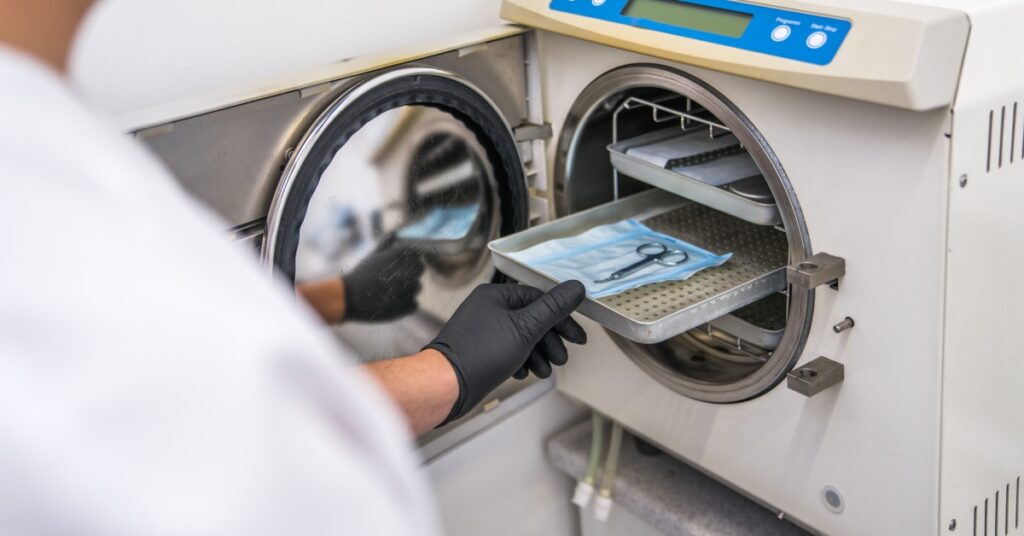Regulatory guidance documents exist to help device manufacturers meet requirements to stay compliant and obtain market approval. In the world of medical device cleaning, however, there is often more than one way to validate reprocessing procedures. The FDA does not necessarily hold specific requirements or device-specific recommendations for medical device cleaning. However, they provide general considerations and recommendations for reprocessing instructions, labeling, and validation.
Reprocessing validation must be adequate for and tailored to the specifications of each individual product. Using the FDA’s guidance, issued in March of 2015 and titled “Reprocessing Medical Devices in Health Care Settings: Validation Methods and Labeling Guidance for Industry and Food and Drug Administration Staff”, will simplify the process of reprocessing validation and pre-market submission for approval. Let’s take a look at the guidelines for medical device cleaning with this overview.
Defining Reprocessing
Reprocessing encompasses the entire validated process of taking a clinically used medical device and removing contaminants to make it safe and effective for reuse. This process includes the initial point-of-use processing that occurs right after device use, thorough cleaning in a dedicated cleaning area, and, if necessary, disinfection or packaging and sterilization of the device.
Reprocessing validation, as well as the development of clear reprocessing instructions, is a vital step in the manufacturing of reusable medical devices. This process ensures the safety and efficacy of medical devices throughout their lifespan.
Human Factors in Reprocessing Instructions
One of the biggest challenges in developing reprocessing procedures can be addressing human factors. The reprocessing methods must be tailored to the device’s intended end users. This means improving user comprehension of reprocessing instructions by using uniform terminology and consistent cleaning methods across all products to make instructions easier to understand and follow.
Manufacturers must also address human factor issues and understand both the requirements and limitations of the end user. Reprocessing methods must consider factors such as issues of dexterity or strength, vision and perception, and familiarity with certain common reprocessing practices. For example, can someone with a fever perform the initial cleaning processes of their thermometer after checking their temperature? Incorporating these human factors into the process ensures that the reprocessing requirements are feasible and easy to replicate in a real-world setting.
Labeling and Reprocessing Instructions
Once you have developed reprocessing instructions for your device, you must make those instructions clear and legible through proper labeling. The FDA guidelines for medical device cleaning include six criteria for reprocessing instructions to help manufacturers make their methodology easy for users to understand and follow.
Reflecting the Intended Use
Labeling should make the device’s design and use clear, while the reprocessing method should reflect that design and use. This means the reprocessing procedures will revolve around what the device is supposed to come into contact with. That could be intact skin, mucosal surfaces, sterile tissues, bodily fluids, microorganisms on users’ hands, or other sources of bioburden contamination.
The reprocessing instructions should also address whether the device’s use involves contact with disinfectants or other chemicals. These chemicals can also leave unwanted residue on the device that users must remove as part of reprocessing.
Finally, labeling and reprocessing instructions must address any specific risks the device presents to patients or users.
Instructions for Thorough Cleaning
Thorough cleaning is a crucial step of reprocessing that must precede any microbicidal methods. The device’s reprocessing instructions must provide guidelines detailing this thorough cleaning procedure, including any necessary disassembly, specific cleaning methods or products required, and any protective covers or sheathes users should use.
Instructions should also address proper flushing techniques for devices with flush ports, including endoscopes or laparoscopic instruments, to avoid the buildup of debris that can harm the efficacy of the cleaning process.
Instructions for the Microbicidal Process
Instructions should also address the proper microbicidal process—either disinfection or sterilization—for the medical device. These instructions should detail the sterilization or disinfection processes (low, intermediate or high-level disinfection) tailored to the intended use and risk factors of the device. They must also be consistent with current principles for infection control.
Feasible Instructions and Available Equipment
Manufacturers must take the intended users and setting for the use of their device into account when developing reprocessing instructions. For example, a device intended for use in a hospital or surgery center must have reprocessing methods that professionals can achieve in a standard healthcare facility, as compared to a device used and reprocessed in a dental facility or physician’s office. This is what makes certain sterilization methods, such as steam sterilization, more common than others. The more accessible your methods and required equipment are to a broader market, the easier it is to accomplish your reprocessing methods in a real-world setting.
If your device’s reprocessing method requires uncommon methods, such as ethylene oxide (EtO) sterilization, which is being phased out in many healthcare markets, that device must be targeted toward users with access to those methods. Equally important is to note that any devices, accessories, and cleaning products necessary for reprocessing must be approved for the market and readily available for end users.
Making Instructions Comprehensive
A device’s reprocessing instructions must include a detailed overview of the process to ensure precise, safe, and effective reprocessing procedures. While you can format instructions in different ways depending on your device and labeling, the instructions for use (IFU) should minimally include the following elements as indicated in the FDA guidance:
- Any necessary special accessories
- Point-of-use processing instructions
- Device disassembly and reassembly
- Thorough cleaning instructions
- Necessary cleaning agents
- Rinsing instructions
- Necessary lubricating agents
- Instructions for a visual inspection
- Disinfection or sterilization instructions
- Instructions for reducing sterilant residuals
- Drying instructions
- Information on the reuse life of the device
- Additional labeling, such as non-sterile labels for products that must be sterilized before use
- Patient or lay use instructions for devices with non-professional intended users
- Reference to further guidelines or accessory labeling
- Manufacturer contact information
If any of these elements are not applicable for the device, manufacturers may be asked to justify why they aren’t included in the instructions for use when submitting their product for approval.
Making Instructions Understandable
Finally, manufacturers must ensure that their instructions are clear and legible for end users. This includes factors such as the physical design of the instructions, including font size, text, and layout. It also includes steps for ensuring clarity, such as providing instructions in sequential order, using clear and simple language, and including detailed information for each step.
Manufacturers can also provide further documentation for additional clarity in their instructions. This can include references to additional texts, charts, and diagrams that are available as physical copies or as web pages the end users can access. Keep in mind that any provided graphics should also include text explanations for easy understanding.
Validation of Reprocessing Methods
Understanding validation guidelines simplifies the process of proving that the reprocessing method works for the specific device design and that the specific device design works for its intended use and meets the user needs. This process includes the validation of cleaning processes and final disinfection or sterilization process.
Validation of cleaning processes demonstrates that your IFU allow the device to undergo further reprocessing through the sterilization or disinfection process. It also proves that users can reuse the device safely at the end of reprocessing.
Validation of the final microbicidal process documents that the disinfection or sterilization methods are safe and effective for the device. FDA recommendations point medical device manufacturers (OEM) toward any device-specific guidance available from the FDA or other regulatory bodies to help validate disinfection and sterilization methods.
HIGHPOWER Labs is well-versed in the various guidelines for medical device cleaning, disinfection and sterilization validation. Learn more about our proven methodology and choose us as your trusted partner for medical device sterility test and validation when you visit us today.


